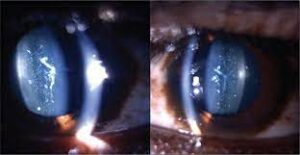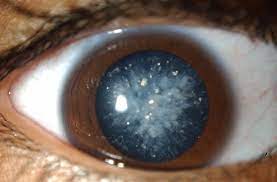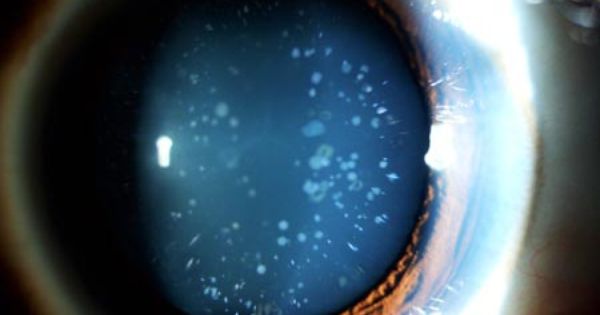If you have been experiencing vision problems and have been told that you have a blue dot cataract, you may be wondering what that is and what can be done about it. A blue dot cataract is a type of cataract that affects the center of your lens. It can cause your vision to become blurry and distorted. In this blog post, we will discuss the causes of a blue dot cataract and how it can be treated.
Contents
What Is Blue Dot Cataract?
 Blue dot cataract is a type of eye condition that occurs when a cloudy area appears in the center of the lens. This type of cataract causes a blue or gray spot to appear, hence its name. It is most commonly seen in people over age 40, but can occur at any age and affect either one or both eyes.
Blue dot cataract is a type of eye condition that occurs when a cloudy area appears in the center of the lens. This type of cataract causes a blue or gray spot to appear, hence its name. It is most commonly seen in people over age 40, but can occur at any age and affect either one or both eyes.
Blue dot cataracts are developmental cataracts that look like small, white, bluish dots scattered in the nucleus and cortex of the lens. They typically go unnoticed until 18-24 months of age and most patients don’t need them removed before adulthood. Treatment often consists of a surgical procedure to remove the lens and replace it with an artificial one.
There are various symptoms of blue dot cataracts which are as follows:
- Visual disturbances such as blurred vision, double vision, and difficulty reading or seeing at night.
- Sensitivity to light and glare.
- Difficulty in recognizing colors.
- Halos or starbursts around bright lights.
- Yellowing of the lens of the eye.
In fact, this cataract may cause you to see some colors as not as vibrant. Your vision might become yellowish or brownish over time. At first, the change in color may be unnoticeable. However, eventually, it can make it difficult to tell blue and purple apart.
What Causes Blue Dot Cataracts?

:
Sometimes called blue dot or type 1 cerulean cataract, the disease is hereditary and polymorphic of unknown cause. It is located on the same chromosome as the galactokinase deficiency gene (GALK1) but with a linked autosomal dominant pattern of transmission. The opacity appears on one or both eyes and commonly appears in children or middle-aged people.
There are various causes of blue dot cataracts:
- Aging: As we age, the proteins in our eyes can become damaged or denatured. This causes them to clump together and form a cloudy area in the lens of the eye, which is known as a cataract.
- UV Exposure: Excessive exposure to ultraviolet (UV) light from the sun or other sources can damage the proteins in the eye and cause a cataract.
- Diabetes: High blood sugar levels due to diabetes are associated with an increased risk for developing blue dot cataracts.
- Steroid Medications: Prolonged use of steroid medications can lead to cataracts as well.
- Trauma: Trauma to the eye can also cause cataracts. This can happen as a result of an accident or even having surgery on the eyes.
- Genetic: Blue Dot cataract is a genetic disease, caused when one or more genes aren’t working correctly.
- Inheritance: There are two copies of most genes in every person. The number of copies that need to have disease-causing variants affects the way a disease is inherited, and blue dot cataract is inherited as follows:
Is Blue Dot Cataract Curable?
Unfortunately, we have not found any preventative treatments for cataracts. However, surgery may be necessary to improve vision and avoid amblyopia, a condition that can result from leaving cataracts untreated. In the case of a blue dot cataract, it is typically recommended that the cataract be surgically removed as soon as possible to avoid further vision damage.
The surgery used to remove a blue dot cataract is called phacoemulsification. Phacoemulsification involves using ultrasound energy to break up and then remove the cataract from the eye. This surgery is typically performed on an outpatient basis and can be done with either local or general anesthesia.
Is Blue Dot Cataract Congenital?
If you have an autosomal dominant disorder, it’s caused by a single copy of the mutant allele. Both males and females are affected equally, and each child has a 50% chance of inheriting the mutant allele from either parent. Because of this, blue dot cataract is generally considered to be a congenital disorder.
Many patients with cerulean cataracts have preserved vision and don’t need to have the cataract removed until adulthood. Because newborns aren’t usually affected by it, this type of cataract is often considered a form of developmental cataract rather than a true congenital one. Unlike other forms of cataracts, it can take up to ten years for the progression of cerulean cataracts to be noticed. However, children who develop signs such as nystagmus and amblyopia may require surgery sooner than it would normally happen in adults.
How Is It Diagnosed?
The diagnosis of a blue dot cataract is done through a complete eye exam, including dilated pupil examination. During the eye exam, your doctor will use a slit-lamp microscope and/or ophthalmoscope to look at the back of your eye for any signs or symptoms of the condition. Your doctor may also recommend other tests such as a visual acuity test, retinal photography, or an ultrasound to help make the diagnosis. If a blue dot cataract is present, it will appear as a dark blue or black spot on the lens of your eye when viewed through the microscope.
With cerulean cataracts, the differential diagnosis includes other congenital, developmental, and traumatic cataracts. These can usually be distinguished by physical examination and laboratory tests.
What Are The Treatment Options?
There are various treatment options:
Surgery
Surgery is the standard treatment option for blue dot cataracts. The surgery involves removing the clouded lens and replacing it with an artificial intraocular lens (IOL). This improves vision dramatically, restores color perception, and reduces glare sensitivity.
- Refractive laser surgery, uses laser technology to reshape the cornea in order to improve vision.
- Intraocular lens implantation, where an artificial lens is surgically implanted into the eye in order to replace the natural lens of the eye. Cataract surgery involves removing the clouded lens and replacing it with a plastic or synthetic one.
Medications
Corticosteroids may be used to reduce inflammation. These may be taken orally or injected directly into the eye.
Lifestyle Changes
To prevent further damage, it’s important to protect your eyes from direct sunlight and other sources of UV radiation, such as welding arcs. Wearing sunglasses when outside can help protect your eyes from these harmful rays. Additionally, smoking should be avoided, and eating a healthy diet can help protect your vision. Vitamin and mineral supplements may also be prescribed in order to improve overall eye health. The patient may need to wear glasses or contact lenses in order to correct their vision.
In extreme cases, a corneal transplant may be required in order to restore vision.
Overall, blue dot cataracts are treatable with surgery or medications but they can still cause serious vision problems if left untreated. It’s important to see an eye doctor regularly for regular check-ups in order to detect any changes in vision early on. With proper treatment, blue dot cataracts can be managed and vision can be restored.
No matter what treatment option you choose, it’s important to be proactive in protecting your vision from further damage and seek help as soon as possible for any changes in your vision. Early detection and treatment are key for the best outcome.
What Are The Precautions Taken During Surgery?
The precautions taken during surgery are as follows:
- The patient must be given local anesthesia before the operation to minimize pain and discomfort.
- Antibiotics must be prescribed prior to surgery in order to prevent infection.
- The eye surgeon will use a microscope or lens system during the procedure in order to view the area of the blue dot cataract precisely.
- After the cataract is removed, a synthetic lens may be implanted to replace the natural lens of the eye.
- Post-operative care is important and should include regular visits to the ophthalmologist in order to monitor any post-surgical complications or changes in vision.
- Regular use of prescription eye drops may also be necessary in order to reduce any inflammation or infection.
- Patients should take extra precautions when engaging in certain activities, such as swimming and contact sports.
- It is important to wear protective eyewear if engaging in these activities in order to protect the eye from further injury.
- The patient must follow their doctor’s instructions in order to ensure a successful recovery.
- It is important to keep the eye clean and use artificial tears if the eyes become dry or uncomfortable.
- Sunglasses are also recommended, as they can help protect the eyes from further damage caused by UV radiation.
- Most importantly, it is important to remember that the blue dot cataract is a serious eye condition and thus requires immediate medical attention.
Early diagnosis can help minimize the effects of this disease on vision, so it is important to get regular check-ups with an ophthalmologist in order to ensure optimal eye health.
Conclusion
It may be concluded that a blue dot cataract is a rare form of cataract that can cause vision impairment. It is caused by a combination of genetic and environmental factors, and treatment typically involves surgically removing the affected lens and replacing it with an artificial one. While this condition cannot be prevented, early diagnosis is key to successful treatment and lessening its impact on vision.
Therefore, regular eye exams are essential for individuals who may be at risk of developing blue dot cataracts. For patients already diagnosed with this condition, regular follow-up visits and monitoring for signs of worsening vision can help ensure the best possible outcome.
Cataract surgery is a safe and painless procedure. At MantraCare we have a team of experienced eye surgeons, who will be happy to answer any questions on cataract surgery. Call us at +91-9711116605 for any inquiries.
